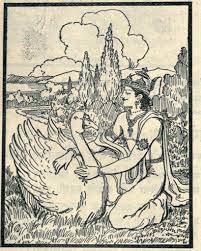
Nala’s saga, immortalized in the Vana Parva of the Mahabharata, resonates through time, captivating hearts with its tale of love, betrayal, and redemption. Adapted into various renditions, this timeless epic finds profound expression in the 12th-century masterpiece, the “Nishadha Charita,” penned by Sriharsha, one of the illustrious mahakavyas of Sanskrit literature.
The narrative unfolds with Nala, the esteemed King of Nishadha, encountering a magnificent swan amidst the verdant forests. Intrigued by the bird’s melodious tales of Damayanti’s unparalleled beauty and virtues, Nala becomes enamored with the princess. Impressed, he instructs the swan to convey his admiration to Damayanti, setting in motion a sequence of events destined to shape their lives.
In a momentous swayamvara, where Damayanti, adorned in resplendent attire, selects her life partner amidst a gathering of illustrious suitors, Nala emerges victorious, chosen by the princess herself. Even the celestial deities, enraptured by Nala’s virtues, depart the ceremony, showering blessings upon the couple. However, their joyous union incurs the wrath of Kali Purush, aggrieved by Damayanti’s choice of a mortal over the divine.
Fuelled by resentment and envy, Kali vows to disrupt their happiness, vowing to lead Nala astray from the path of righteousness and virtue. Thus begins a tumultuous journey fraught with trials and tribulations, as Kali endeavors to sow seeds of discord between Nala and Damayanti. Despite Nala’s unwavering integrity and purity, it takes twelve arduous years for Kali to ensnare his soul, exploiting a minor fault to wreak havoc upon his life.
Under Kali’s malevolent influence, Nala descends into a vortex of despair and betrayal, engaging in a perilous game of dice with his treacherous brother Pushkara. Consumed by greed and folly, Nala gambles away his wealth, kingdom, and ultimately, his very identity. In a heart-wrenching twist, Nala forsakes Damayanti, abandoning her in the wilderness as he succumbs to the darkness within.
Lost in the depths of despair, Nala’s fate takes an unexpected turn as he encounters Karkotaka Naga, a benevolent serpent whose gratitude transforms Nala into an unrecognizable dwarf named Bahuka. Guided by the serpent’s counsel, Bahuka finds refuge in the kingdom of Ayodhya, serving King Rituparna as a charioteer and cook, concealing his true identity amidst the bustling courtly affairs.
Meanwhile, Damayanti, undeterred by adversity, embarks on a relentless quest to find her beloved husband. Her journey unfolds like a tapestry of resilience and fortitude, encountering myriad challenges and seeking solace in the kindness of strangers along the way. From confronting perilous snakes to seeking refuge with her aunt Queen Bhanumati of Chedi, Damayanti’s unwavering resolve propels her ever closer to her cherished goal.
In a moment of serendipity, Damayanti’s unwavering faith is rewarded as she uncovers the truth behind Bahuka’s enigmatic identity. Recognizing each other amidst the tumult of emotion, Nala and Damayanti are finally reunited, their souls intertwining in a timeless embrace of love and redemption.
Empowered by righteousness and fueled by love, Nala embarks on a quest to reclaim his lost kingdom and restore honor to his name. Armed with newfound wisdom and resolve, he confronts Pushkara in a climactic rematch, staking all that he holds dear in a bid for redemption. Through a tumultuous journey of sacrifice and self-discovery, Nala emerges victorious, overcoming the malevolent influence of Kali and reclaiming his rightful place as the revered King of Nishadha.
In a poignant conclusion to their saga, Nala and Damayanti find solace in each other’s arms, their love transcending the trials of fate and adversity. United once more, they embark on a new chapter of their lives, blessed with two children, Indrasena and Indrasenaa, whose lineage heralds a legacy of resilience and fortitude.
As Kali, vanquished and humbled, offers Nala a boon, the king selflessly seeks protection for all who tread the path of righteousness, shielding them from the malevolent influence of darkness. Thus, Nala’s tale stands as a beacon of hope and resilience, inspiring generations to embrace the light of virtue and love amidst the shadows of adversity.
